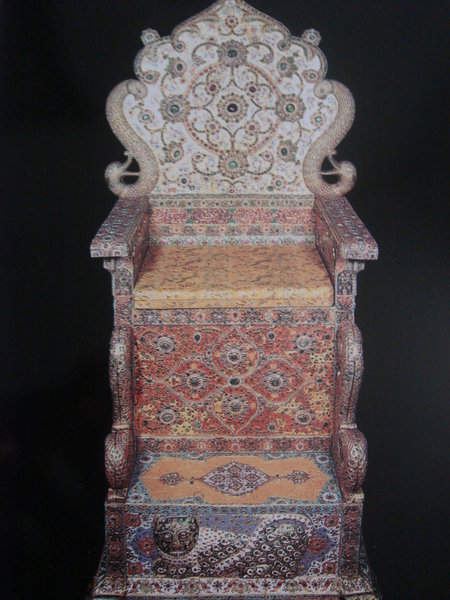The Throne Verse (‘āyat-l-kursī) in Light of Rhetorical Analysis
By Mehdi Azaiez
During the first meeting of the Qur’an Seminar in October of 2012 (an academic project dedicated to advancing scholarly understanding of the Qur’anic text, hosted at the University of Notre Dame), I proposed a particular reading of the throne verse based on rhetorical analysis. This method, which was developed by Michel Cuypers, aims to excavate the Qur’an’s compositional structure. It relies on fundamental “figures of speech” such as parallelism and chiasmus. As Cuypers explains, “the aim of the analysis will therefore essentially be to pinpoint the various forms of symmetry which make up the text, defining the relationships which they have with one another, and the textual divisions which they determine.”[1] I present here an example by applying one aspect of this method to the famous throne verse.
My aim here is to show how compositional features of the verse highlight embedded meanings. I will start by presenting the text and its transliteration and then move on to focus on its composition. (Cuypers’ method also proposes an intertextual study, but for the present purposes we will limit the discussion to composition). Lastly, I will briefly compare examples of classical exegesis of this verse and the result of the rhetorical analysis proposed here.
1. Text
اللَّهُ لَا إِلَٰهَ إِلَّا هُوَ الْحَيُّ الْقَيُّومُ ۚ لَا تَأْخُذُهُ سِنَةٌ وَلَا نَوْمٌ ۚ لَهُ مَا فِي السَّمَاوَاتِ وَمَا فِي الْأَرْضِ ۗ مَنْ ذَا الَّذِي يَشْفَعُ عِنْدَهُ إِلَّا بِإِذْنِهِ ۚ يَعْلَمُ مَا بَيْنَ أَيْدِيهِمْ وَمَا خَلْفَهُمْ ۖ وَلَا يُحِيطُونَ بِشَيْءٍ مِنْ عِلْمِهِ إِلَّا بِمَا شَاءَ ۚ وَسِعَ كُرْسِيُّهُ السَّمَاوَاتِ وَالْأَرْضَ ۖ وَلَا يَئُودُهُ حِفْظُهُمَا ۚ وَهُوَ الْعَلِيُّ الْعَظِيمُ
2. Transliteration
Allāhu lā ˈilāha ˈillā huwa al-ḥayyu al-qayyūmu lā taˈḫuḏuhū sinatun wa- lā nawmun lahū mā fī as-samāwāti wa-mā fī al-ˈarḍi man ḏā allaḏī yašfaʿu ʿindahū ˈillā bi-ˈiḏnihī yaʿlamu mā bayna ˈaydīhim wa-mā ḫalfahum wa-lā yuḥīṭūna bi-šayˈin min ʿilmihī ˈillā bi-mā šāˈa wasiʿa kursiyyuhu as-samāwāti wa al-ˈarḍa wa-lā yaˈūduhū ḥifẓuhumā wa-huwa al-ʿaliyyu al-ʿaẓīmu
3. Composition
اللَّهُ لَا إِلَٰهَ إِلَّ
A هُوَ الْحَيُّ الْقَيُّومُ
B لَا تَأْخُذُهُ سِنَةٌ وَلَا نَوْمٌ
C لَهُ مَا فِي السَّمَاوَاتِ وَمَا فِي الْأَرْضِ
D مَنْ ذَا الَّذِي يَشْفَعُ عِنْدَهُ إِلَّا بِإِذْنِهِ
يَعْلَمُ مَا بَيْنَ أَيْدِيهِمْ وَمَا خَلْفَهُمْ
D’ وَلا يُحيطونَ بِشَيءٍ مِن عِلمِهِ إِلّا بِما شاءَ
C’ وَسِعَ كُرسِيُّهُ السَّماواتِ وَالأَرضَ
B’ وَلا يَئودُهُ حِفظُهُما
A’ وَهُوَ العَلِيُّ العَظيمُ
4. Some remarks about the composition of this verse
This presentation reveals a symmetrical structure, wherein units of text are arranged concentrically (ABCD/x/D’C’B’A’). The relationship between those units is one of identity: terms and segments have similar meanings,[2] and each segment responds or corresponds to its pair. The first segments (A and A’) possess three words each. Both share an identical term (huwa) and use synonymy which corresponds to attributes of God (al-ḥayyu al-qayyūmu responding to al-ʿaliyyu al-ʿaẓīmu). The second segments (B and B’) highlight the role of God as one who maintains the existence of the Universe (lā taˈḫuḏuhū sinatun wa- lā nawmun /lā yaˈūduhū ḥifẓuhumā). The parallelism of the third segments (C, C’) refers to the cosmology and sovereignty of God (lahū mā fī as-samāwāti wa-mā fī al-ˈarḍi/ wasiʿa kursiyyuhu as-samāwāti wa al-ˈarḍa). And finally, the parallelism of the fourth segments (D,D’) draws attention to God’s will (man ḏā allaḏī yašfaʿu ʿindahū ˈillā bi-ˈiḏnihī/ wa-lā yuḥīṭūna bi-šayˈin min ʿilmihī ˈillā bi-mā šāˈa). These four main topics—God’s attributes, God’s power, God’s sovereignty, and God’s will— converge on one central idea: the knowledge of God embraces all things (yaʿlamu mā bayna ˈaydīhim wa-mā ḫalfahum). Located in the center of the whole structure, this segment has no relationship of identity with any other segment.
As Cuypers points out—and Nils W. Lund before him—this central segment is the semantic pivot. In the perspective of rhetorical analysis, the center gives meaning to the whole structure. Rhetorical analysis thus understands this verse’s principal message to be the glorification of the knowledge of God. This interpretation seems to confirm explanations of the verse by classical mufassirūn, as shown below.
5. Classical interpretation and rhetorical analysis
A brief look at Islamic exegesis reveals the existence of a debate about the nature of the term kursiy (segment C’), which gives the verse its name. On one hand, some traditions insist that this term means a material reality and object which represents the place of the footstool of God,[3] while other traditions identify the kursiy as a metaphor of God’s knowledge. Tabari accepts the latter explanation and comments:
This may be proved by His saying, “And the preservation of them does not burden Him,” which means that He is not burdened by the preservation of that which his knowledge encompasses, which is all that is in the heavens and the earth. God also said of His angels that they say in their prayers, “Our Lord, You encompass all things in mercy and knowledge” (40,7). [4]
Rhetorical analysis thus supports this particular exegetical reading of the verse.
[1] Michel Cuypers, The Banquet, A Reading of the Fifth Sura of the Qur’an, Convivium Press, 2009, p. 35.
[2] Ibid.
[3] Mahmoud Ayoub, The Qur’an and its interpreters, State University of New York Press, 1984, p. 250.
[4] Ibid., p. 250-251.
© International Qur’anic Studies Association, 2013. All rights reserved.

